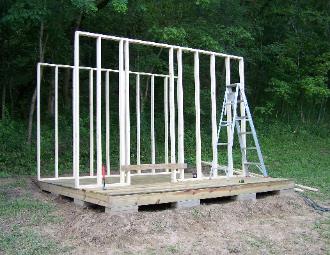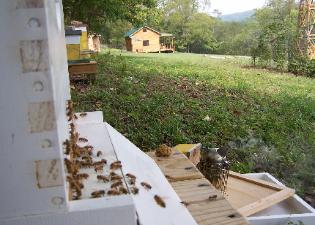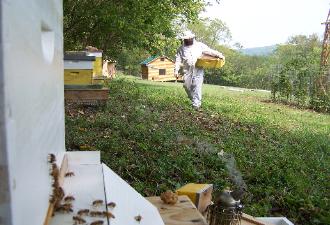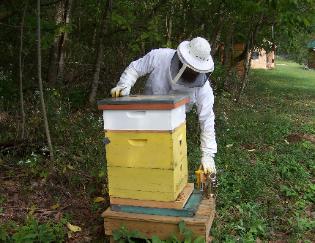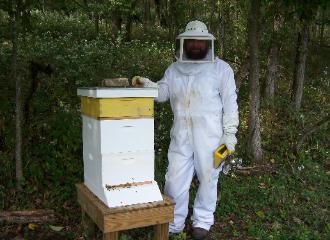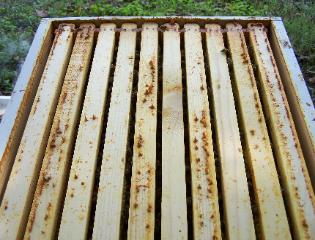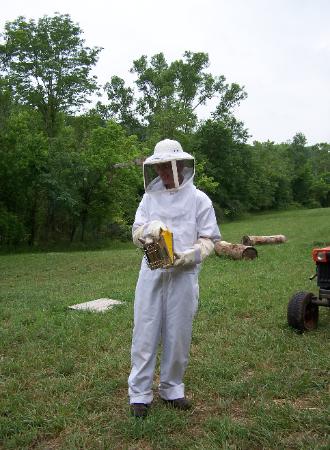
| Bee Keeping at Straight Creek Valley Farm |
There are so many things to share about our life on Straight Creek Valley Farm in southern Ohio. Everything has been a learning experience for this New York City born and raised lady, but on this page I’d like to share what we have learned after nine seasons of bee keeping. My husband Greg was born and raised in the country, and his grandfather, now long passed away, was a bee keeper. Greg remembers as a little boy following his grandfather out to the hives and watching him work the bees and Greg has always dreamt of keeping bees himself. So after we bought the farm in the spring of 2003, Greg read all the bee books that he could get his hands on, learned as much as he could from the Internet, and finally, ordered a bee hive and some equipment from Bee Commerce. He built the hive, made up of two deep hive boxes and three shallow boxes called supers, in our city basement over the winter. We then ordered five pounds of live bees and a marked queen over the internet and sat back to wait patiently until spring when the bees would be shipped. On a designated day in the spring, the live bees arrived at our city post office, much to the distress of the post office workers. Bee Commerce had told us the bees’ preplanned arrival date so that I could call the post office and advise them of the shipment. Mail carriers will not deliver live creatures, so it was important that the post office had a phone number so that they could reach me immediately after the bees’ arrival. We did not want our bees sitting in a hot back room or on a delivery dock for long. The post office called and told us with real concern that our bees were escaping and we needed to pick them up immediately! My husband could not leave work at that moment, so I hurried down to pick up the bees by my self. I had never met a honey bee before and I had no idea what to expect. As soon as I saw the bees, I could understand the post office’s distress about the “escape”. The wooden box holding our bees was surrounded by fifteen to twenty large local bee-like flying creatures. I could clearly see our smaller bees through the wire mesh of their travel cage. I could also hear their buzzing and I assumed that the larger locals were just curious and checking the new arrivals out. Several postal workers watched. I had an old blanket with me that I thought might help if the bees had in fact been escaping. I figured that I could wrap up the package of escaping bees in the blanket and avoid being stung. Even though the bees were not actually escaping, I was still glad to have the blanket. I tried to stay calm, and walked over to the packaged bees and whisked the larger bees away with the blanket. I then calmly picked up the packaged bees, amazed by the suddenly louder buzzing, and carried them out to my car. Thankfully, the local city bees did not follow me as I walked off of the loading dock. The postal workers seemed very relieved as I took the bees away. Later that afternoon, we drove out to Straight Creek with our buzzing cargo to introduce them to their new home. I will not give you all of the details of what we did and how we did it, but I will say that we followed the directions and advice set forth in Bee Keeping for Dummies. The book definitely provided us with the basic information we needed to start out as novice beekeepers. By the time it was fall, we knew that our first hive was healthy and had enough honey stored to get them through the winter. They did not, however, produce enough honey for us to harvest in their first season. That is because they were a brand new colony and had to spend their summer getting the hive ready for winter. We watched with fascination all summer. First, they drew out the new wax foundation, that we had placed in the hive frames, into wax comb. Once the comb was built, the queen began to lay her eggs in the lower brood chamber wax cells, and the workers began to fill the outside and upper chamber frames with the colony’s own honey stores to last them through the winter.. Things have a way of turning out though, because we did manage to harvest honey our first season as bee keepers. Earlier in the year, as we were ordering the standing seam tin roof for our farm cabin, we met a wonderful man named Jim Higgins. We had noticed that the building supply store where we purchased our roof had an indoor bee hive display along the back wall. My husband found the display fascinating and as we looked at the display, an elderly gentleman came up to us. We now know him as Jim Higgins, a much published and renowned bee keeper who, very fortunately for us, lives in southern Ohio. Jim later introduced us to two homeless bee hives, whose bee keeper had passed away over the winter. With Jim’s help we moved the hives to Straight Creek. The two established colonies set right to gathering Straight Creek pollen and nectar, and by early August they had filled a total of five supers. These five supers made up our first harvest. Once again, we followed the guide lines set down in Beekeeping for Dummies, adapting and learning as we went through the process. The book was very helpful indeed, and of course, our harvest was done the old fashioned way, with a hand cranked four frame extractor, a pot of hot water and two uncapping knives (so there was always a warm knife ready to cut through the cappings). Straight Creek Farm is off the grid, so we do almost everything the old fashioned way. (To learn about the details of our first honey harvest, click here). We ended up with about one hundred and sixty, twelve ounce, jars of clear light summer honey that we have enjoyed giving away to family and friends. We hoped to have a second somewhat smaller harvest in the fall, of the stronger goldenrod honey, but the extremely dry late summer and early fall weather made for a poor honey flow. We were still pleased though, with our first season of beekeeping, for our Straight Creek Honey in great demand. Perhaps it is because our first season price was right (free), but perhaps it was because it really was a delightful, light clear honey. We learned, through our first and later honey harvests, that extracting he honey is a sticky, but very rewarding task. We decided, rather than spread stickiness throughout our main cabin with repeated harvests, that we would build a sugar shed, a smaller version of the larger cabin, topped with more of the green standing seem tin roof that lead us to Jim Higgins. The shed, measuring twelve by twelve feet with a small covered porch and separate entrance storage room, is worth it's weight in gold. It is wonderful to be able to store all of our honey and bee keeping supplies in the sugar shed (as well as our maple sugaring equipment) giving us more space in the main cabin, and, as an added bonus, when family and friends come to Straight Creek to visit, we can use the sugar shed as a guest house. There is no doubt about it. Bee keeping is a fascinating adventure and I am excitedly looking forward to many years' of honey harvesting. |
The sugar shed under construction and completed.. You can see that we simply placed it on cement pavers.
Getting the foundation dug, laying down the floor and getting it framed was a good weekend's work for the
two of us and then, once framed in, we finished it off over the next several months.
Getting the foundation dug, laying down the floor and getting it framed was a good weekend's work for the
two of us and then, once framed in, we finished it off over the next several months.
From the front porch of the new bee hive you can see the two older hives and our cabin in the distance.
Greg puts a new super on one of the older hives. We have found the
smoker (in his left hand) to be an invaluable tool, though we try not to
use too much smoke. When we open the hive, as seen in the photo
below, a gentle smoking keeps the bees deep inside, gorging on their
honey so they can fly away from what they think is a "forest fire".
smoker (in his left hand) to be an invaluable tool, though we try not to
use too much smoke. When we open the hive, as seen in the photo
below, a gentle smoking keeps the bees deep inside, gorging on their
honey so they can fly away from what they think is a "forest fire".
I found a box of old meat packer's cotton string
at a farm auction. I was the successful bidder
at six dollars. The thick cotton string is a
perfect slow burning material for the smoker,
and with twenty rolls, I should have enough to
last a good twenty years!
at a farm auction. I was the successful bidder
at six dollars. The thick cotton string is a
perfect slow burning material for the smoker,
and with twenty rolls, I should have enough to
last a good twenty years!
Christine readies the smoker for a trip to the hives.
Straight Creek Valley Farm
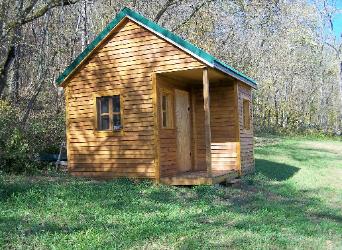
| Join us for the 2014 Beginner Sustainable Beekeeping Class |
